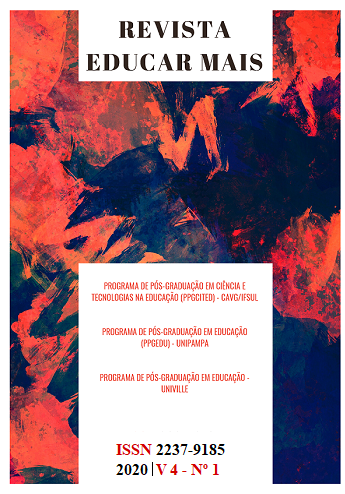Figural treatment using Geoboard Octododecagon: a geometric work space
DOI:
https://doi.org/10.15536/reducarmais.4.2020.40-56.1655Keywords:
Figural Treatment, Geometry, Geometrical Working Space, Visualization.Abstract
This article presents results of a research that aimed to verify how students of master's degree in Mathematics decided about a problem-situation to use the artefact geoboard octododecagon and then solving problems of plane geometry using figural registers. After solving the problem and build this object, students used it, together with elastic bands, for solutions of one of the questions. From that first registration, it was initiated the development of visual ability, which continued to be developed with the second type of register, in the GeoGebra software. We conclude that the didactic involved in Geometrical Working Space-(GWS), organized, involving teachers, students and a university institution, allowed, from these types of figural registers, to develop the visualization as a mental construct.Downloads
References
ALMOULOUD, S. Fundamentos da didática da matemática. Curitiba: Ed. UFPR. 2007.
ARCAVI, A. The role of visual representation in the learning of mathematics. In: NORTH AMERICAN CHAPTER OF THE PME. Proceedings of the 21st Annual Meeting of PME-NA, ERIC, Clearinghouse for Science, Mathematics and Environmental Education, OH, pp. 55–80. Educational Studies in Mathematics 52: 215. 1999.
BALDINI, L. A. F. Construção do Conceito de Área e Perímetro: Uma Sequência Didática com Auxílio de Software de Geometria Dinâmica, no Estado do Paraná. Londrina: Universidade Estadual de Londrina, 2004. 211p. Dissertação de Mestrado.
CHAUHAN, S. A meta-analysis of the impact of technology on learning effectiveness of elementary students. Computers & Education, v. 105, p. 14-30, 2017.
D’AMORE, B. Elementos de Didática da Matemática. (trad. Maria Cristina Bononi). São Paulo: Livraria da Física. 2007.
DA SILVA, R. S.; LOPES, D. C. V. A construção de conceitos da geometria plana com o uso de materiais concretos e digitais: uma experiência com Tangram. Revemat: Revista Eletrônica de Educação Matemática, v. 8, n. 1, p. 179-198, 2013.
DAVIS, P. J.; HERSH, R. A experiência matemática. Lisboa: Gradiva. 1995.
DUVAL, R. Semiosis y Pensamiento Humano: registros semióticos y aprendizajes intelectuales. Colômbia: Universidad del Valle. 2004.
DUVAL, R. Rupturas e Omissões entre manipular, Ver, Dizer e Escrever: História de uma Sequência de Atividades em Geometria. As contribuições da Teoria das Representações Semióticas Para o Ensino e Pesquisa na EDUCAÇÃO MATEMÁTICA. MORETTI, M.T. e BRANDT, C. F. (org.) Ijuí: Editora da UNIJUI, 2014, pp. 15-38. 2014.
GÓMEZ-CHACÓN, I. M..; KUZNIAK. A. Spaces for geometric work: figural, instrumental, and discursive geneses of reasoning in a technological environment. International Journal of Science and Mathematics Education 13: 201-226. National Science Council, Taiwan,2013.
FREUDENTHAL, H. Mathematics as an Educational Task. Holland: D. Reidel Publishing Company. 1973.
KNIJNIK, G.; BASSO, M. V. A.; KLUSENER, R. Aprendendo e ensinando matemática com o Geoplano. 2. ed. Ijuí: Unijuí Editora, 2004.
KUZNIAK, A. Personal Geometrical Working Space: a Didactic and Statistical Approach. In: Gras R., Suzuki E., Guillet F., Spagnolo F. (eds) Statistical Implicative Analysis. Studies in Computational Intelligence, vol 127. Springer, Berlin, Heidelberg. 2008.
KUZNIAK, A. L'espace de travail mathématique et ses génèses. Annales de Didactique et de Sciences Cognitives, v. 16, p. 9-24. @2011, IREM de STRASBOURG. 2011.
LEIVAS, José Carlos P. Imaginação, Intuição e Visualização: A riqueza de possibilidades da abordagem geométrica no currículo de Cursos de Licenciatura de Matemática. Tese (Doutorado em Educação, Universidade Federal do Paraná), Curitiba, Pr, 2009, 294p.
MOYER, P. S.; BOLYARD, J. J.; SPIKELL, M. A. What are virtual manipulatives?. Teaching children mathematics, v. 8, n. 6, p. 372-377, 2002.
PEREIRA, J. S.; OLIVEIRA, A. M. P. Materiais manipuláveis e engajamento de estudantes nas aulas de matemática envolvendo tópicos de geometria. Ciênc. educ. (Bauru), Bauru , v. 22, n. 1, p. 99-115, 2016 .
PIAGET, J.; INHELDER, B. A representação do espaço na criança. Porto Alegre: Artes Médicas. 1993.
SABBATIELLO, E. E. El Geoplano- un recurso didáctico para la enseñanza dinamica de la geometría plana elemental – su aplicación e utilización en la escuela primária– de Elsa Elena Sabbatiello, Buenos Aires. 1967.
Downloads
Published
How to Cite
Issue
Section
License
DECLARATION OF RESPONSIBILITY: I hereby certify that I partially or fully participated in the conception of the work, that I did not hide any links or financial agreements between the authors and companies that may be interested in this article publication. I certify that the text is original and that the work, partially or fully, or any other work with a substantially similar content written by me, was not sent to any other journal and it will not be send while my submission is being considered by Revista Educar Mais, whether in printed or electronic format.
The author responsible for the submission represents all the authors of the manuscript and, when sending the article to the journal, guarantees s/he has obtained the permission to do so, as well as s/he guarantees the article does not infringe upon anyone’s copyright nor violate any proprietary rights. The journal is not responsible for the opinions expressed.
Revista Educar Mais is Open Access, does not charge any fees, whether for submission or article processing. The journal adopts Budapest Open Access Initiative (BOAI)’s definition, i.e., any users are permitted to read, download, copy, distribute, print, search and link to the full texts of these articles.
All the articles are published under the Creative Commons Atribuição-NãoComercial 4.0 Internacional license. The authors keep the copyright of their production. That way, they must be contacted directly if there is any interest in commercial use of their work.
















 Esta obra está licenciada com uma Licença
Esta obra está licenciada com uma Licença 